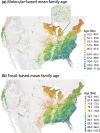Community phylogenetics at the biogeographical scale: cold tolerance, niche conservatism and the structure of North American forests
- PMID: 24563577
- PMCID: PMC3920643
- DOI: 10.1111/jbi.12171
Community phylogenetics at the biogeographical scale: cold tolerance, niche conservatism and the structure of North American forests
Abstract
AimThe fossil record has led to a historical explanation for forest diversity gradients within the cool parts of the Northern Hemisphere, founded on a limited ability of woody angiosperm clades to adapt to mid-Tertiary cooling. We tested four predictions of how this should be manifested in the phylogenetic structure of 91,340 communities: (1) forests to the north should comprise species from younger clades (families) than forests to the south; (2) average cold tolerance at a local site should be associated with the mean family age (MFA) of species; (3) minimum temperature should account for MFA better than alternative environmental variables; and (4) traits associated with survival in cold climates should evolve under a niche conservatism constraint. LocationThe contiguous United States. MethodsWe extracted angiosperms from the US Forest Service's Forest Inventory and Analysis database. MFA was calculated by assigning age of the family to which each species belongs and averaging across the species in each community. We developed a phylogeny to identify phylogenetic signal in five traits: realized cold tolerance, seed size, seed dispersal mode, leaf phenology and height. Phylogenetic signal representation curves and phylogenetic generalized least squares were used to compare patterns of trait evolution against Brownian motion. Eleven predictors structured at broad or local scales were generated to explore relationships between environment and MFA using random forest and general linear models. ResultsConsistent with predictions, (1) southern communities comprise angiosperm species from older families than northern communities, (2) cold tolerance is the trait most strongly associated with local MFA, (3) minimum temperature in the coldest month is the environmental variable that best describes MFA, broad-scale variables being much stronger correlates than local-scale variables, and (4) the phylogenetic structures of cold tolerance and at least one other trait associated with survivorship in cold climates indicate niche conservatism. Main conclusionsTropical niche conservatism in the face of long-term climate change, probably initiated in the Late Cretaceous associated with the rise of the Rocky Mountains, is a strong driver of the phylogenetic structure of the angiosperm component of forest communities across the USA. However, local deterministic and/or stochastic processes account for perhaps a quarter of the variation in the MFA of local communities.
Keywords: Forest phylogenetics; National Forest Inventory; North America; niche conservatism; phylogenetic signal representation; random forests; trait evolution; tree communities; tropical conservatism hypothesis.
Figures








Similar articles
-
Latitudinal and elevational patterns of phylogenetic structure in forest communities in China's mountains.Sci China Life Sci. 2020 Dec;63(12):1895-1904. doi: 10.1007/s11427-019-1663-4. Epub 2020 May 6. Sci China Life Sci. 2020. PMID: 32382981
-
Ecological determinants of mean family age of angiosperm trees in forest communities in China.Sci Rep. 2016 Jun 29;6:28662. doi: 10.1038/srep28662. Sci Rep. 2016. PMID: 27354109 Free PMC article.
-
Multiple filters affect tree species assembly in mid-latitude forest communities.Oecologia. 2018 May;187(1):245-253. doi: 10.1007/s00442-018-4122-6. Epub 2018 Apr 6. Oecologia. 2018. PMID: 29626230
-
Measuring biodiversity to explain community assembly: a unified approach.Biol Rev Camb Philos Soc. 2011 Nov;86(4):792-812. doi: 10.1111/j.1469-185X.2010.00171.x. Epub 2010 Dec 14. Biol Rev Camb Philos Soc. 2011. PMID: 21155964 Review.
-
Conservatism and diversification of plant functional traits: Evolutionary rates versus phylogenetic signal.Proc Natl Acad Sci U S A. 2009 Nov 17;106 Suppl 2(Suppl 2):19699-706. doi: 10.1073/pnas.0901635106. Epub 2009 Oct 20. Proc Natl Acad Sci U S A. 2009. PMID: 19843698 Free PMC article. Review.
Cited by
-
Phylogenetic relatedness of woody angiosperm assemblages and its environmental determinants along a subtropical elevational gradient in China.Plant Divers. 2020 Sep 10;43(2):111-116. doi: 10.1016/j.pld.2020.08.003. eCollection 2021 Apr. Plant Divers. 2020. PMID: 33997543 Free PMC article.
-
Species and Phylogenetic Diversity of Woody Plants Shift With the Elevational Gradient in Subtropical Forests in South China.Ecol Evol. 2025 Jul 14;15(7):e71761. doi: 10.1002/ece3.71761. eCollection 2025 Jul. Ecol Evol. 2025. PMID: 40661918 Free PMC article.
-
Phylogenetic assemblage structure of North American trees is more strongly shaped by glacial-interglacial climate variability in gymnosperms than in angiosperms.Ecol Evol. 2016 Apr 3;6(10):3092-106. doi: 10.1002/ece3.2100. eCollection 2016 May. Ecol Evol. 2016. PMID: 27252830 Free PMC article.
-
Darwin's naturalization conundrum can be explained by spatial scale.Proc Natl Acad Sci U S A. 2020 May 19;117(20):10904-10910. doi: 10.1073/pnas.1918100117. Epub 2020 May 4. Proc Natl Acad Sci U S A. 2020. PMID: 32366659 Free PMC article.
-
Are phylogenies resolved at the genus level appropriate for studies on phylogenetic structure of species assemblages?Plant Divers. 2020 Nov 28;43(4):255-263. doi: 10.1016/j.pld.2020.11.005. eCollection 2021 Aug. Plant Divers. 2020. PMID: 34485767 Free PMC article.
References
-
- Angiosperm Phylogeny Group. An update of the Angiosperm Phylogeny Group classification for the orders and families of flowering plants: APG III. Botanical Journal of the Linnean Society. 2009;161:105–121.
-
- Ashlock PD. The uses of cladistics. Annual Review of Ecology and Systematics. 1974;5:81–99.
-
- Bell CD, Soltis DE, Soltis PS. The age and diversification of the angiosperms rerevisited. American Journal of Botany. 2010;97:1296–1303. - PubMed
-
- Broecker WS, Kennett JP, Flower BP, Teller JT, Trumbore S, Bonani G, Wolf W. Routing of meltwater from the Laurentide Ice Sheet during the Younger Dryas cold episode. Nature. 1989;341:318–321.
-
- Butler MA, King AA. Phylogenetic comparative analysis: a modeling approach for adaptive evolution. The American Naturalist. 2004;164:683–695. - PubMed
LinkOut - more resources
Full Text Sources
Other Literature Sources
